Leather Education & Community Links
Exploring the Leather Community:

The leather community is a loosely knit community composed of individuals, partners and groups who typically like to wear leather accessories and garments, most often like those of the post-WWII biker culture. Core leather values include brotherhood, integrity, honor and service.
For many who wear it, black leather is a sensual second skin. Wearing black leather clothing commonly expresses brotherhood with other leatherfolk. It may also express heightened masculinity, love of motorcycles, independence and participation in leather cultural events.
For many it also includes an appropriation of erotic power, engagement in leather fetishism, consensual kink and BDSM activities.
The common foundation the leather community or leather culture is built upon are the principals of trust, honor and respect.
Today the broader leather culture includes gay, lesbian, straight, bisexual, transsexual and pansexual practitioners. Folks with related interests including uniforms, rubber, western gear and erotic play are also included.
Gay Leather Culture Emerges:

Motorcycle culture emerged in the United States in the 1920s and 1930s, often revolving around racing. During World War II multiple armies had motorcycle divisions in the European war zone. Leather apparel offered warmth and protection from accidents.
The image of the leather-clad biker evolved from the biker groups that formed following the end of World War II in 1945. For some returning veterans, post World War II motorcycling offered camaraderie, adventure, excitement and occasional danger as a substitute for wartime experience. Men joining motorcycle clubs formed brotherhood bonds which came from a tradition long established in military values and the warriors before them. Use of leather apparel from World War II motorcycle riding carried on to post-war culture.
These early motorcycle clubs and their events were not gay, however, motorcycle events also provided a way for interested gay men to meet each other at a time when homosexuality was medically classified as a psychological disorder and considered a crime in all US states and most countries, punishable by years in prison or in some countries even execution.
The gay male leather subculture began to emerge in the late 1940’s out out the post-WWII biker culture and provided a masculine alternative to the stereotype effeminate image of gay men that had existed prior to the war.
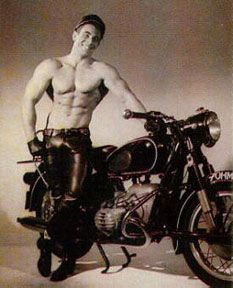
The 1953 outlaw biker film The Wild One, starring Marlon Brando, played on pop-cultural fascination with the July 1947 Hollister “riot” and promoted an image of free-spirited, motorcycle riding, masculine independence. This rebellious image appealed to many men during the confining mainstream culture of the 1950’s, including some gay men who found wearing black a leather jacket, a black leather cap, black leather boots and jeans an appealing alternative to the pervasive effeminate stereotype of gay men. If they could afford it they also took to riding motorcycles.
Photographs of men in leather published by English photographer Tom Nicoll and drawings of gay biker leathermen published by Finish artist Tom of Finland, beginning in the mid-1950’s, helped to further define the emerging image of gay leathermen. Physique Pictorial, a body building magazine published in Los Angeles by photographer Bob Mizer included many of Tom of Finland’s drawings along with photographs by Mizer and others.
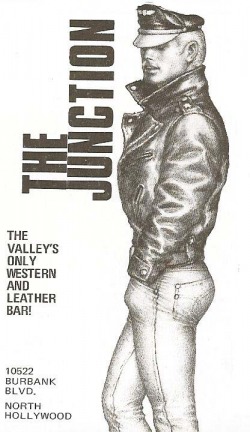
Gay Leather / Biker Bars
Gay bars catering to the leather/biker clientele emerged in the 1950’s and 1960’s and became the easier places for leathermen to meet and find camaraderie. Los Angeles and New York are reported to have had gay the first gay leather/biker bars by the mid-1950’s.
- The Cinema Bar on Melrose, the first documented gay bar catering to leather/biker patrons in Los Angles, was opened by 1953, The Club Bar at Western and Melrose followed a few years later. Additional gay leather bars opened in LA during 1960’s and 1970’s including the Arena, Falcon’s Lair, The Stud, Griff’s, The Gauntlet, the Bunkhouse, the Driveshaft, the Officer’s Club, the the Black Pipe, the Detour, the Eagle, the Renegade, the Hayloft, the Spike and One Way.
- Shaw’s, the first documented leather/biker bar in New York City was opened by 1953, followed by The Lodge which was opened by 1954. Other NYC popular leather bars in the 1960’s and 1970’s included the Mineshaft, The Eagle, The Spike, RamRod and Rawhide.
- Amsterdam’s first leather bar and hotel, the Argos, opened in 1957.
- The first gay leather bar in Chicago was the Gold Coast, founded in 1958.
- San Francisco’s first documented leather bar was the Why Not which opened in 1960, although it soon closed.
- The Tool Box opened in San Francisco in 1961. In 1964 LIFE magazine published a feature on “Homosexuality In America” with its graphic depiction of San Francisco’s Tool Box.
As the leather subculture began to foster the development of loosely knit local leather communities, the leather bars became unofficial “community centers” offering leathermen a place to gather, connect with each other, share information and raise funds for various causes.
Gay Motorcycle Clubs
Gay motorcyclists got to know each other and rode together on weekends. The Satyrs, founded in Los Angeles in on Thanksgiving weekend in 1954, is considered the first documented gay motorcycle club. The Satyrs began as a group of seven gay men who were active in the L.A. motorcycle culture. The Satyrs organized outings known as runs or rides to out of town secluded campgrounds for camping trips, away from LAPD raids, also providing a space where men could explore activities illicit in the 1950’s. The Satyrs held their first Badger Flats Run in 1962.
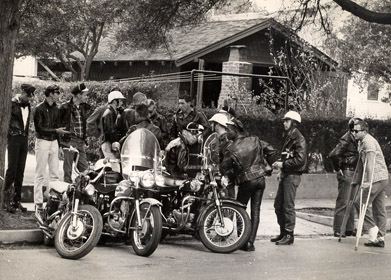
Other early gay motorcycle clubs included:
- Oedipus, also in Los Angeles, was formed in 1958.
- Early San Francisco clubs included the Warlocks and California Motor Club, both founded in 1960.
- Chicago’s Second City Motorcycle Club was founded in 1963.
- New York’s Empire City Motorcycle Club was founded in 1964.
- The 69-Club in London was founded in 1965.
- Blue Max Motorcycle Club founded in Los Angeles in 1968.
- Similar clubs emerged in other cities including Amsterdam and Berlin during the 1960’s.
- By 1979 there were reportedly over 20 clubs in California alone. Some clubs were more formal, dressing in uniforms for events, others were less formal.
These clubs became family, members spent weekends and holidays together and helped each other out when needed. Because of potential police raids, early gay motorcycle groups, like other gay groups, were typically secretive as openness could result in members loss of jobs and criminal prosecution.
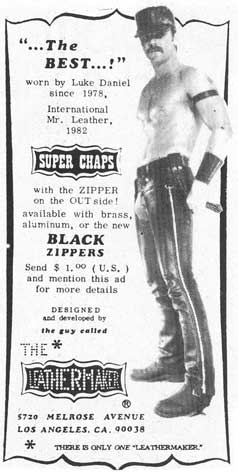
Gay motorcycle clubs, like the clubs of straight motorcycle culture in general, offered brotherhood, adventure, and typically reflected a disaffection with the mainstream culture of post-World War II America. Perhaps as a result, the leather community that emerged from the motorcycle clubs also became the practical and symbolic location for gay men’s open exploration of consensual kink and responsible BDSM.
While leather motorcycle boots, belts and jackets could be obtained from motorcycle shops, other leather gear was homemade during the early years. As gay leather interest grew, leather specialty shops began to create and sell leather fetish gear for a more specific kinky clientele. One of the first was The Leathermaker which was opened by D. Lyn Sterling on Melrose in Los Angeles in 1960.
The Fight for Gay Rights
In the post World War II years all states and most countries had some form of law criminalizing sodomy. In the early 1950’s Wisconsin Senator Joseph McCarthy lead the “lavender scare” which led to the mass dismissal of homosexuals from government service, effectively normalizing persecution of homosexuals through bureaucratic institutionalization of homophobia.
During the 1950’s through the mid-1970’s gay leather bars, like other gay bars and popular gay hangouts, were subject to sudden raids by the police to satisfy political interests, depending on state laws. By the 1960’s some patrons and bar owners began to challenge these raids:
- May 1959, at Cooper’s Donuts, a popular after-hours coffee shop located between two gay bars on Main Street in Los Angeles, the Harold’s and the Waldorf. Two cops arbitrarily picked five customers demanded ID’s and led them out. As the cops packed them in the back of the squad car, one of the men objected, then the others scattered out of the other car door. The police faced a barrage of coffee cups, spoons, trash from other customers and people in the area. They fled in their car, calling for backups as a crowd formed leading to social unrest in the area.
- December 31, 1964, several organizations in San Francisco, including the Council on Religion and the Homosexual, SIR, the Daughters of Bilitis, and the Mattachine Society held a fund-raising New Year’s Costume Ball at the California Hall on Polk Street. San Francisco police had agreed not to interfere; however, on the evening of the ball, the police showed up in force surrounding the California Hall, conducted multiple “inspections,” and took pictures of the 600-plus persons entering the ball.. Four lawyers supporting the rights of the participants to gather were arrested. The police activity proved an embarrassment for the police department as news spread throughout the city. Twenty-five of the most prominent lawyers in San Francisco joined the defense team, and the judge directed the jury to find the defendants not guilty before the police had even had a chance to begin their argument when the case came to court.
- January 1, 1967, plain clothed police infiltrated the Black Cat Tavern on Sunset Blvd. in Los Angeles. Police began beating patrons and ultimately 14 were arrested for kissing. The police activity started a riot which spread to other neighboring businesses where police officers knocked down a bar owner, a woman, and beat two bartenders unconscious. In response to the police raid, activists organized one of the earliest known demonstrations in support of LGBTQ civil rights, on February 11, 1967, 300-600 attendees protested police brutality and discriminatory laws.
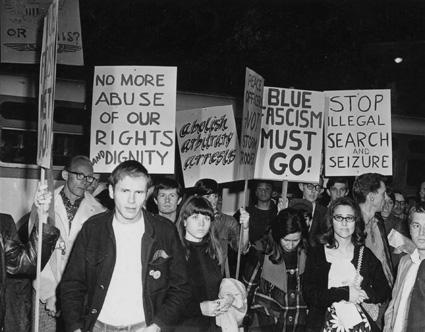
- August 1968, vice squad officers and six LAPD officers burst into The Patch, a gay bar in Wilmington, CA, demanding IDs and making arbitrary arrests. Lee Glaze, the bar owner, led bar patrons carrying flowers to a 3:00 am “flower power style” demonstration at the Harbor Division Police Station. Rev. Troy Perry was at the Patch with his boyfriend Tony Valdez during the raid, Valdez was one of those arrested. Empathy for his partner and others affected led Rev. Perry to found the Metropolitan Community Church in October 1968.
- June 28, 1969, four plainclothes policemen, two patrol officers and two detectives raided the Stonewall Inn in Greenwich Village, New York City when 205 people were in the bar. Some bar patrons refused to provide identification, prompting police to kick and beat people. A crowd began to grow outside. A female patron was hit on the head with a nightstick and shoved into the police wagon, leading to a crown rebellion which turned violent and forced the police to retreat into the Stonewall Inn for several hours. The rebellion lasted for several days.
- August 20, 1972, a dozen police raided a HELP (Homophile Effort for Legal Protection) monthly fundraiser at the Black Pipe, a Los Angeles area leather bar, arresting 21 men. HELP president Larry Townsend is among those arrested. The police were surprised when the organization fought back.
- On April 10, 1976, over a hundred LAPD officers, with Chief Ed Davis present, raided a charitable “slave auction” fund raising event at the Mark IV Baths in Hollywood and bragged to reporters that they had freed the slaves. 40 men were arrested. The expensive raid, conservatively estimated at $150,000, was criticized by the city council and no one was convicted.
In 1967 the Supreme Court ruled in Redrup v. New York that the consensual sale of obscene material to legal adults is constitutionally protected, opening the way for publications to include full nudity. The Los Angeles Advocate (later Advocate) begins publication in 1967.
The Leatherman’s Handbook by Larry Townsend, published in 1972, epitomizes the association of the leather subculture with BDSM. Townsend described in detail a subculture of gay males who wore leather and casually engaged in sadomasochistic sex with one another.
In 1973 the American Psychiatric Association issued a resolution stating that homosexuality was not a mental illness or sickness. The statement continued to say the APA supports “civil rights legislation at local, state, and Federal levels that would insure homosexual citizens the same protections now guaranteed to others.”
In 1975 a consenting adults law for residents over 18 years old repealed existing laws on sodomy in California. A handful of other states had also repealed sodomy laws. By 2002, 36 states had repealed their sodomy laws or their courts had overturned them. On June 26, 2003, the U.S. Supreme Court in Lawrence v. Texas struck down the Texas same-sex sodomy law, ruling that this private sexual conduct is protected by the liberty rights implicit in the United States Constitution.
Women’s leather/biker groups also emerged during the late 1970’s and 1980’s. In 1976 the informally formed Dykes on Bikes, led the San Francisco Gay Freedom Day Parade for the first time, later becoming a San Francisco lesbian motorcycle club. In 1978 sixteen women formed Samois, a lesbian-feminist BDSM organization in San Francisco, believed to be the first lesbian BDSM group in the United States. The Outcasts were formed in San Francisco in 1984 to include all the “faggot-identified dykes, bisexuals, transsexuals and other weirdos and perverts who wanted a more inclusively.”
The AIDS epidemic in the early 1980’s devastated the gay population in general, including leather men and women. Out of the devastation, however, a more cohesive leather community including leathermen and leatherwomen working together emerged. The growing leather community raised money to help fight AIDS and benefit local charities.
The early 1980’s also saw increased attention on safer sex and BDSM activities. To emphasize the concept of safe, voluntary, and consensual activities, the idea of SSC or “Safe, Sane and Consensual” emerged. The actual term SSC is attributed to slave David Stein and first appeared in the statement of purpose of the GMSMA (Gay Male S/M Activists) in 1983.

Traditions and Protocols Define a Leather Identity:
Throughout the history of the leather culture a variety of traditions have been observed.
Trust, Honor and Respect: The common foundation the leather culture is built upon are the principals of trust, honor and respect. More than mere words, these values are basic to society, not just leather folk. Leather folk believe that if we follow these principles in our daily lives, we become role models for our families, both conventional and leather.
From the post WWII beginnings through the 1970’s what is now often referred to as the old guard developed and defined the predominant leather culture. Many gay veterans returning after World War II wanted to retain many of the positive elements of their military experience and the same time hang out socially with other masculine men, they found this among other motorcycle riders. Riding together they embraced a lifestyle of camaraderie, adventure, rights and rituals mostly based on military protocols and rituals, with some variations by region.
Old guard practices emphasized brotherhood, loyalty, integrity, discipline, honor, respect, and service and are said to have promoted a stricter lifestyle, education, and intra-community privilege based on successive ranks or levels. As with the military these early leathermen had been accustomed to, rules governed what guys wore and what they could do. The old guard code emphasized strict formality and typically fixed dominant or submissive roles, men typically started at the bottom and worked their way up. Leather boots, Levis 501 blue jeans, a wide leather belt and a white t-shirt were all a new man would start out with, additional leathers were typically earned as a rite of passage. On the down side, outsiders who didn’t have an interest in riding motorcycles generally weren’t trusted and found it difficult to enter the scene.
By the late 1970’s there was a gradual rebellion against the old guard rigidity. While dedication to core values remained, the new guard or new leather culture that emerged included a new emphasis on choices, or identity: a person might identify as a submissive or a dominant instead of being required to start from the bottom and work up. Switching and a greater variety of approaches to eroticism became popular.
New leather bars emerged offering more variety where it was easier for gay men to meet each other. New clubs formed ranging from traditional bike clubs to special interest clubs. New types of more inclusive events emerged. Drummer Magazine began publication in 1975 helping bridge the way between the old guard and a new broader way of thinking. The Leather Journal began publication in 1987, communicating news about clubs, events, and community festivals and organizations.
This new leather community also began to embrace diversity and variety. Today leather culture includes gay, lesbian, straight, bisexual, transsexual and pan-sexual practitioners. This more diverse culture also embraces those who like uniforms, rubber, cowboy gear, puppy play and other fetishists.
Leather Flag:
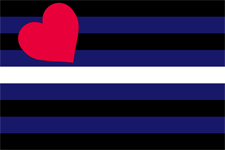
On May 28, 1989, at the International Mister Leather contest in Chicago, Tony DeBlase presented his design for a Leather Pride Flag. In an editorial in Drummer magazine, DeBlase explained that “The flag is composed of nine horizontal stripes of equal width. From the top and from the bottom, the stripes alternate black and royal blue. The central stripe is white. In the upper left quadrant of the flag is a large red heart. I will leave it to the viewer to interpret the colors and symbols.”
Although the creator of the flag did not attribute any colors to the flag, in succeeding years others have commonly described the colors as: black is for leather and for permanence; blue is for devotion, loyalty, and community; white is for purity and innocence; and the red heart is for the love of leathermen for each other and for their community.
Leather Contests:
Leather contests have existed for years. Local leather contests provide local organizations and businesses the opportunity to raise money for charities, increase exposure of the organization or business. draw potential new members and customers to the event, and offer community members something fun to do. In many cases they also offer an opportunity for various organizations to work together for a common purpose. They offer non-leather people an introductory look the leather culture and the hosting organization(s) and meet leatherfolk.
The earliest local contests focused on sashing sexy hot men. As new titles emerged the expectations changed to being sexy and having an activist mentality. By the mid-1980’s title holders became viewed as community leaders and role models, representing themselves as ambassadors for their city or state. Some title holders host events including fund raisers for charitable causes.
Title contestants should be prepared to explain the activity and goals of the organization or business they will be representing, basic information about leather culture, why they are competing for a title and what they would like to do if selected.
Leather contests may also be held for a city, state, region. Some contests offer the winners an opportunity to move on to compete at a city, state or regional contest, at International Mr. Leather or at another international contest.
International Mr. Leather:
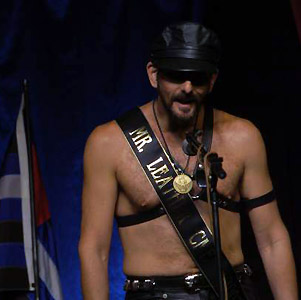
International Mr. Leather (IML) was established in 1979 by Chuck Renslow, owner of the Gold Coast in Chicago, and his partner Dom Orejudos. The IML contest grew out of the Mr. Gold Coast contest. Held each May, the conference now spans several days, and includes the IML competition, speakers, socials, themed dance parties and a leather market. To compete, IML contestants must either be the winner of a bar, local or regional leather contest or be sponsored by a leather bar, business, club, or organization.
CMEN holds its Mr. CMEN Leather contest each year during the West Coast Gathering each August, the winner is sponsored as a contestant for IML the following May. Gay Naturist International holds a Mr. GNI Leather contest at the GNI Gathering each August. Other contestants included regional and state contest winners, metropolitan area contest winners, organization contest winners and local bar contest winners. For more information visit Gay Community Events and Information.
Major Events:
Folsom Street Fair in San Francisco, the self acclaimed biggest leather event in the world, was first held in 1984. It is held in late September each year. Folsom Street East is held in New York City each June, it is the largest outdoor fetish street festival on the East Coast, first held in 1997.
Berlin’s Easter in Berlin Leather Festival, Europe’s biggest gay leather and fetish event which takes place every year at Easter, was first held in 1975. Folsom Europe street fair is held each September in Berlin. Amsterdam Leather Pride is held each October, first held in 1996. London’s Fetish Week each July, which began in 2010, includes men who enjoy leather, uniforms, rubber, sports and other fetishes.
The Leather Archives & Museum opened in Chicago in 1996, and moved to its permanent 10,000-square-foot, two-story home in 1999. The Museum preserves material from various leather communities, houses exhibits relating to leather community history and sends traveling exhibits around the country.
Additional Reading:
- Andrews, Vincent L. The Leather and BDSM Handbook. 2018, Adynaton Publishing. ISBN 978-1-7325279-0-4
- Baldwin, Guy. The Leather Contest Guide; A Handbook for Promoters, Contestants, Judges and Titleholders. 2nd Edition. 2004, Daedalus Publishing Company, Los Angeles. ISBN 1-881943-08-9.
- Baldwin, Guy. Ties that Bind; SM / Leather / Fetish Erotic Style; Issues, Commentaries and Advice. 2nd Edition, 2003, Daedalus Publishing Company, Los Angeles. ISBN 1-881943-09-7.
- Davolt, Robert. Painfully Obvious; An Irreverent & Unauthorized Manual for Leather/SM. 2003, Daedalus Publishing Company, Los Angeles. ISBN 1-881943-19-4.
- Townsend, Larry. The Leatherman’s Handbook. Silver Jubilee Edition, 2000, L.T. Publications, Beverly Hills, CA ISBN 1-881684-19-9 (Original Edition published by Olympia Press in 1972)
Online Information Resources:
- The Leather Journal
- Leatherati: Leather People, Events and News
- Los Angeles Leather History
- GayLeathermen.com
- leatherclubs.net
- BDSM-Education.com
- BDSM Wiki
- Leather and Roses
- Southwest Leather Conference
- SM Safety
- Tom of Finland Foundation
Additional Information:
- Gay Leather Community Events and Information
- Wearing Leather
- Leather Care
- Leather Shops
- Handkerchief Codes
- Exploring Kink
- Mr. CMEN Leather
Trust, Honor and Respect
Information on this page is from the Leather 101 workshop at the West Coast Gathering, September 2016 – 2019, presented by Rick B. Mr CMEN Leather 2015.
Information on this page is provided for educational purposes and does not imply endorsement by CMEN. Please note that CMEN does not control the content of linked web sites, the organizations who own these web sites accept sole responsibility for their content.
Exploring the Leather Community – Leather Events and Organizations – Wearing Leather – Leather Care – Leather Shops – Hanky Code – Exploring Kink

